Assessing Your Fitness Level and Goals for Home-Based Calisthenics Workouts
Before starting a home-based calisthenics workout routine, it is essential to assess your current fitness level and define your fitness goals. This will help you tailor an effective workout plan that best suits your needs. Begin by identifying your current strengths and weaknesses, as well as any possible limitations such as injuries or medical conditions.
Consider your ultimate fitness goals. Do you want to strengthen and tone specific muscle groups or improve cardiovascular endurance? Are you looking to lose weight or gain muscle mass? Identifying your fitness goals will help you create a workout plan that is tailored to your specific needs.
Remember, building a successful calisthenics workout plan at home requires an understanding of your current fitness level and goals. By assessing where you are starting from and where you want to go, you can create a customized home-based calisthenics workout routine that aligns with your unique needs.
Choosing the Right Calisthenics Exercises for Your Home Workouts
Calisthenics exercises are an excellent way to build strength and endurance from the comfort of your own home. With a plethora of exercises to choose from, it’s essential to select ones that target different muscle groups and meet your specific fitness goals. In this section, we will discuss a few essential calisthenics exercises for home workouts that you can incorporate into your routine.
First on the list are squats. Squats are a fantastic exercise for strengthening your leg muscles, including your glutes, quads, and calves. To perform a basic squat, stand with your feet shoulder-width apart and slowly lower your body by bending at the knees and pushing your hips back, until your thighs are parallel to the ground. Pause, then slowly rise back to a standing position.
Push-ups are another classic calisthenics exercise that targets your chest, shoulders, and triceps. To perform a push-up, begin in a plank position with your hands slightly wider than shoulder-width apart. Slowly lower your body by bending your elbows until your chest touches the ground, then push back up to the starting position.
Pull-ups are an excellent exercise for building upper body strength, particularly your back muscles. If you don’t have a pull-up bar at home, you can use a sturdy horizontal bar or a door frame. Place your hands slightly wider than shoulder-width apart on the bar and pull your body up towards the bar, keeping your elbows close to your sides. Lower yourself back down slowly, and repeat.
Lunges are another great exercise for strengthening your leg muscles, specifically your glutes and quads. Stand with your feet shoulder-width apart, then step forward with one leg and slowly lower your body until your back knee touches the ground. Pause, then push back up to a standing position and repeat on the other leg.
| Exercise | Primary Muscles Worked |
|---|---|
| Squats | Glutes, Quads, Calves |
| Push-ups | Chest, Shoulders, Triceps |
| Pull-ups | Back, Biceps |
| Lunges | Glutes, Quads |
It’s essential to mix up your calisthenics exercises to avoid hitting a plateau, so we’ve included a few additional exercises for you to consider:
- Dips for strengthening your triceps and pecs
- Burpees for a full-body exercise that builds strength and endurance
- Mountain climbers for strengthening your core and lower body muscles
Remember to choose exercises that align with your fitness level and goals. Start with a few basic exercises and gradually increase the difficulty and intensity as you progress. Don’t forget to incorporate proper warm-up and cool-down exercises before and after your calisthenics workouts.
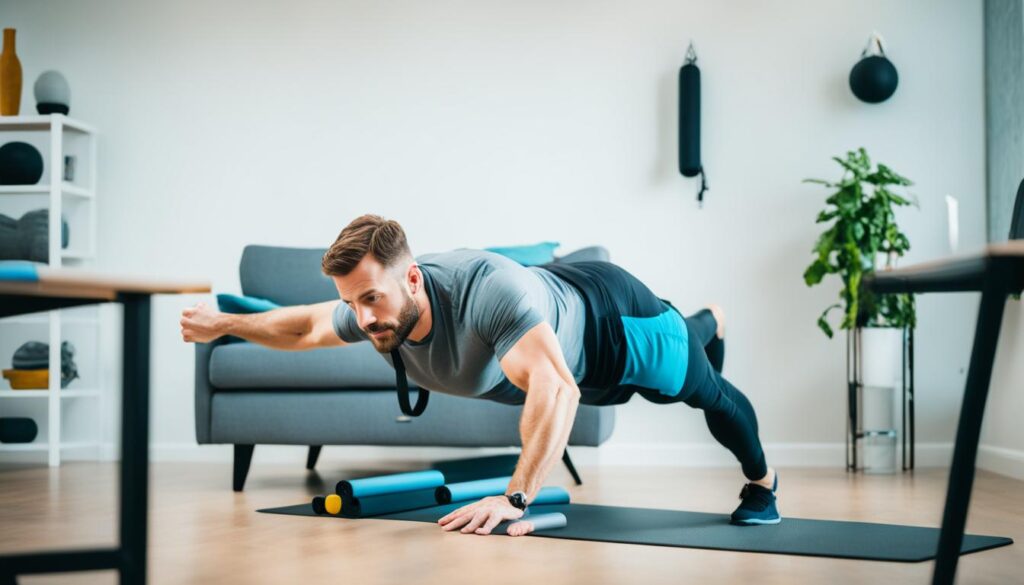
Structuring your Home Calisthenics Routine
When designing your home-based calisthenics workout routine, it’s essential to structure it according to your specific goals and fitness level. Here are some tips and ideas to help you design a well-rounded routine that ensures balanced muscle development:
Determine your Training Split
Your training split refers to how you distribute your workouts across different muscle groups and days. There are various split options you can choose from, including full-body workouts, push-pull-legs, upper-body-lower-body, or specific muscle group training. Consider your goals, fitness level, and available time when selecting your training split.
Incorporate Compound Exercises
Compound exercises target multiple muscles at once, resulting in more efficient workouts. Incorporate exercises like push-ups, pull-ups, squats, and lunges into your routine for optimal results. Note: If you have limited equipment options, modify these exercises or use alternatives.
Add Isolation Exercises for Additional Muscle Development
Isolation exercises target specific muscle groups, allowing for more focused muscle development. Add exercises like bicep curls, tricep extensions, or shoulder raises to your routine for additional muscle development. Consider your goals and training split when including isolation exercises in your routine.
Include Cardio and Flexibility Work
Incorporating cardio and flexibility exercises is essential for overall fitness and injury prevention. Consider adding exercises like jumping jacks, running in place, or stretching to your routine to improve cardiovascular health and flexibility.

Vary your Repetitions and Sets
Varying your repetitions and sets helps avoid plateaus and keeps your workouts challenging. For muscle growth, aim for higher repetitions (8-12) with moderate resistance. For strength gains, aim for lower repetitions (1-5) with heavier resistance. Aim for 3-5 sets per exercise.
Track your Progress and Adjust your Routine
Tracking your progress and making adjustments to your routine is essential for continuous improvement. Keep track of your exercises, repetitions, and resistance levels and adjust them based on your goals and progress.
By following these tips and ideas, you can create a well-structured home calisthenics routine that targets different areas of your body and ensures balanced muscle development.
Setting Time and Frequency for Your Home-Based Calisthenics Workouts
Now that you have selected your calisthenics exercises and structured your home-based calisthenics routine, it’s essential to determine the ideal time and frequency for your workouts. By doing so, you can stay consistent in your efforts and see better progress over time.
Consider the following factors when deciding on the timing and frequency of your home-based calisthenics workouts:
- Your schedule: Look at when you have available time each day or week to fit in your workouts. Try to establish a routine that works for your lifestyle and is realistic to maintain.
- Your goals: If you’re aiming to build lean muscle or increase your strength, you may need to work out more frequently than someone who is just starting. Determine your fitness goals and adjust accordingly.
- Your recovery time: Allow for rest days or lighter workouts to give your muscles time to recover, develop, and grow. Overtraining can lead to overuse injuries and burnout, so it’s crucial to listen to your body and rest when needed.
As a general guideline, aim to complete at least two to three home-based calisthenics workouts per week, with each workout lasting at least 30 minutes. Gradually increase the frequency and duration of your workouts as your fitness level improves.
Remember that consistency is key, so aim to establish a routine that works for you and stick to it as much as possible. Image alt tag: calisthenics training routine for home-based workouts
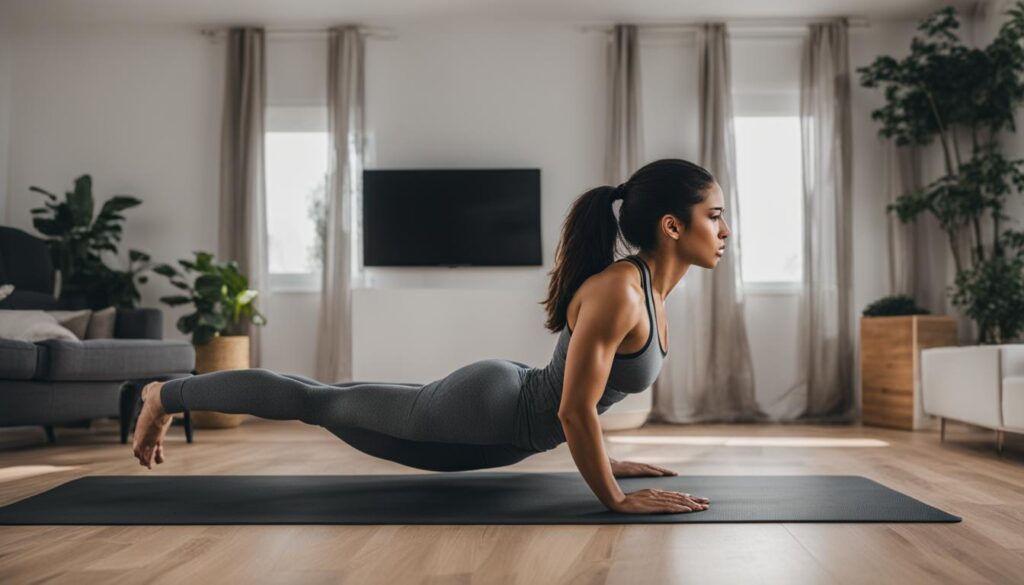
Developing progression strategies for continuous improvement
Building a successful calisthenics workout plan at home requires consistent effort and progression. As your body adapts to your current routine, you’ll need to incorporate new challenges to keep challenging your muscles and making progress.
Here are different methods you can use to develop progression strategies for continuous improvement:
- Increase resistance: To challenge your muscles, you can increase the resistance of your exercises. This can be achieved by using resistance bands, ankle weights or adding weights.
- Vary rep range: Another way to challenge your muscles is to vary the rep range of your exercises. For example, you could do less repetition with more weight or more repetition with less weight, or performing the same exercise for a longer period of time.
- Create supersets: Supersets are exercises that target the same muscle group, but they’re performed back-to-back without rest. This method will challenge your muscles and increase your overall fitness by increasing your heart rate.
- Add plyometric exercises: Plyometric exercises are explosive movements that increase agility, strength, and power. They can be incorporated into your routine as part of your warm-up, or as a separate workout.
Remember that it’s crucial to listen to your body and adjust your routine as needed. Overexertion and injury can occur if these strategies aren’t approached with caution. Keep records of your progress to monitor your growth, and adjust your routine as necessary to keep challenging yourself.
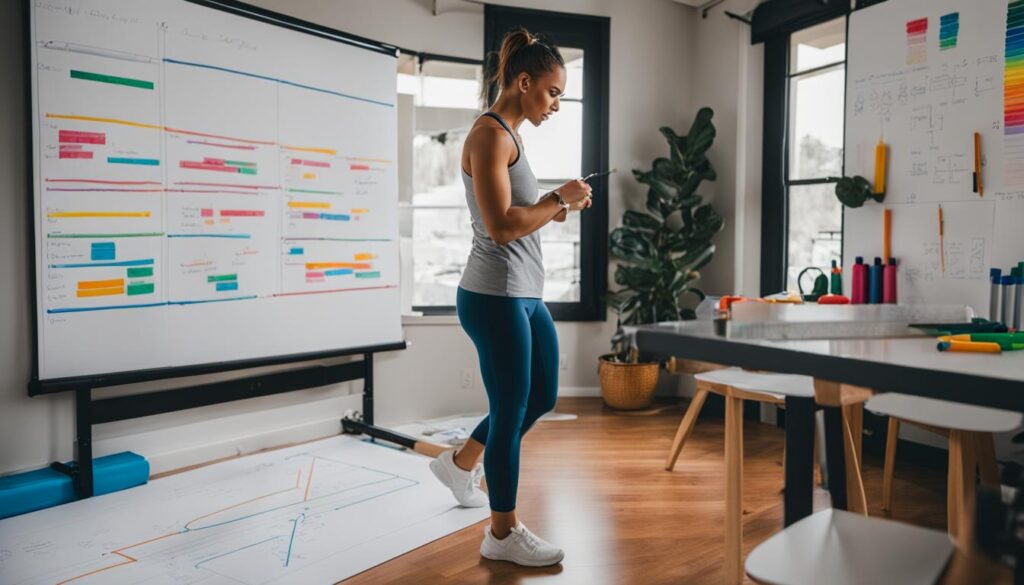
Adapting exercises for limited equipment options at home
Whether you’re short on equipment or just looking for a new challenge, there are many ways to modify common calisthenics exercises to suit your needs. With a little creativity and experimentation, you can maximize your home-based calisthenics workout routine without compromising on efficiency or results.
Here are some ideas on how to adapt calisthenics exercises for home workouts when you have limited equipment options:
Use household items as equipment
Be creative and look around your house for items that can double as workout equipment. For example, you can use a chair or ottoman for dips, a broomstick or mop handle for mobility exercises, or a filled backpack or laundry detergent jug for weighted squats or lunges.
Modify exercises for different difficulty levels
Most calisthenics exercises have various options for modifying difficulty levels. For example, if regular push-ups are too challenging, you can try knee push-ups or wall push-ups instead. If you find squats too easy, try single-leg squats, jump squats, or pistol squats.
Incorporate isometric holds
Isometric holds can add intensity to your workouts without requiring additional equipment. For example, you can hold a plank or wall sit for an extended amount of time, or pause at the bottom of a squat or lunge before coming up.
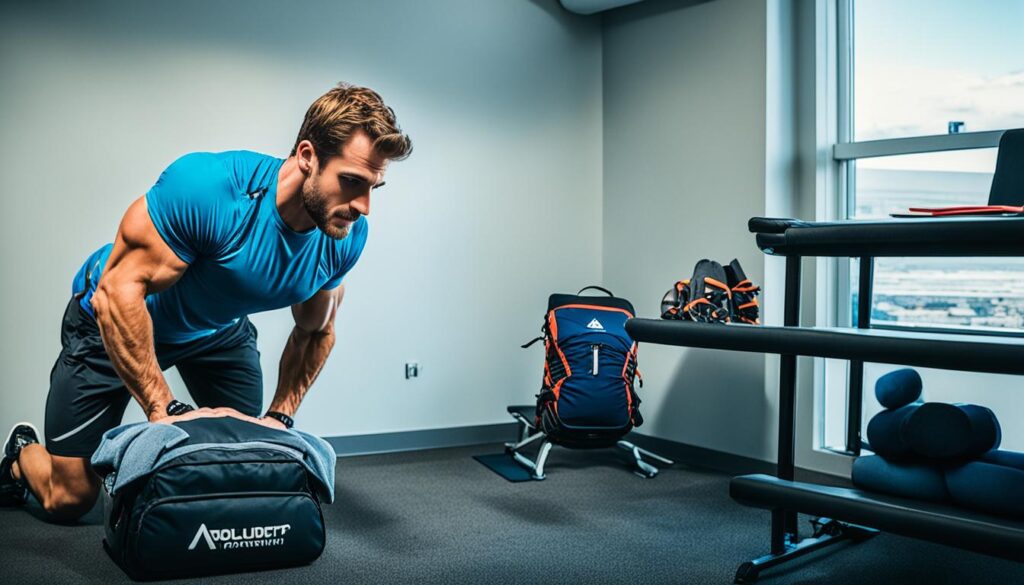
These are just a few examples of how to adapt calisthenics exercises for home workouts with limited equipment options. Experiment with different modifications and techniques to create a customized routine that meets your fitness goals and challenges your body.
Incorporating Flexibility and Mobility Work into Your Routine
Calisthenics exercises improve muscle strength and endurance, but they can also lead to a decrease in flexibility and mobility over time. Incorporating flexibility and mobility work into your routine is crucial for maintaining joint health, preventing injuries and enhancing your overall athletic performance. Here are some home workout ideas for a calisthenics routine:
Dynamic Stretching
Dynamic stretching involves motion and active movement. It can include exercises such as lunges, leg swings, high knee walks and arm circles. Dynamic stretching movements prepare your body for exercise and increase flexibility and range of motion.
Static Stretching
Static stretching is traditional stretching and involves holding a position for a period, without movement. Examples of this include hamstring stretches, quad stretches, calf stretches, and shoulder stretches. Static stretching increases flexibility, improves range of motion and helps prevent muscle imbalances, strains and soreness. Yoga is an excellent way of adding a static stretching routine into your workout at home.
Myofascial Release
Myofascial release involves the use of tools such as foam rollers, balls, and sticks to alleviate tension in the body’s fascia. Foam rolling helps increase blood and nutrient flow to muscles, reduce tightness and soreness, and speeds up recovery time. Incorporate tools into your stretching routine for deeper, more effective recovery.
Use these calisthenics exercises for home workouts to enhance your routine, improve flexibility and mobility, and reduce the risk of injuries.
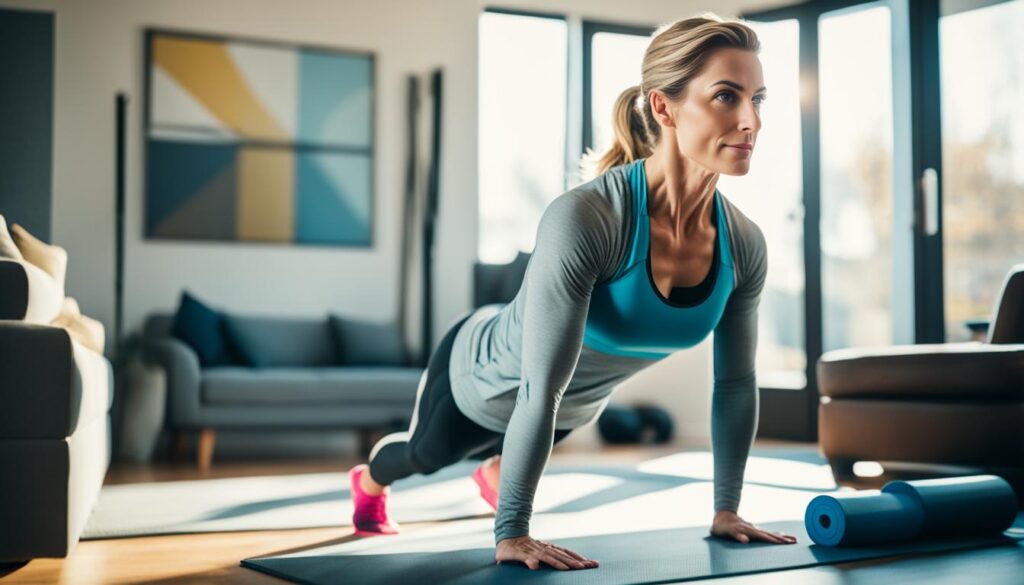
Incorporating Rest and Recovery into Your Home Calisthenics Routine
Rest and recovery are critical components of building a successful calisthenics workout plan at home. Without proper rest, your muscles will not have the opportunity to heal and grow, leaving you vulnerable to injury and stalled progress.
Your home-based calisthenics workout routine should incorporate rest days to allow sufficient time for recovery and repair. Your muscles need time to rest and rebuild after each workout session, so it’s essential to schedule at least one rest day between each workout day. You can use this time for light stretching, foam rolling, or other gentle activities that promote blood flow and aid in recovery.
Rest should not be taken lightly. Overworking your muscles can lead to reduced performance, decreased muscle mass, and chronic fatigue. It’s essential to aim for a balance between intensity and recovery to ensure that your body is progressing towards your fitness goals.
Recovery techniques such as stretching, icing, and massage can also aid in muscle recovery and reduce soreness. Active recovery activities such as walking or cycling can promote blood flow and speed up the healing process.
Remember that consistency and gradual improvement are key to building an effective home-based calisthenics workout routine. By incorporating rest and recovery into your routine, you’ll improve your overall performance and progress towards your fitness goals with greater ease.
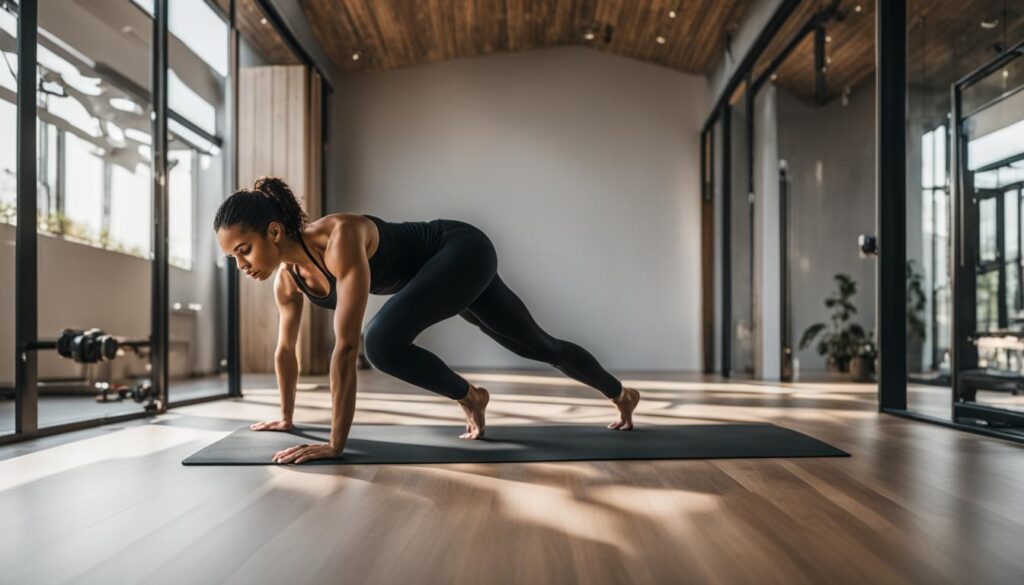
Staying Motivated and Accountable During Your Home Workouts
While working out at home provides many benefits, such as convenience and flexibility, it can also present unique challenges. It’s easy to get distracted by household chores, work responsibilities, or family members. Moreover, you may lack motivation and struggle to stay consistent with your routine, especially if you don’t have a workout buddy or coach to hold you accountable.
Fortunately, there are several strategies you can implement to stay on track and committed to your home-based calisthenics routine:
1. Set Realistic Goals
When designing your home calisthenics routine, it’s essential to set realistic and achievable goals. Instead of aiming for drastic changes overnight, try to focus on gradual progress and celebrate small milestones along the way. For example, you may aim to do five more push-ups next week, rather than doubling your repetitions instantly. This approach will help you build confidence, maintain motivation, and avoid burnout or frustration.
2. Create a Plan and Schedule
To hold yourself accountable and stay consistent with your workouts, it’s crucial to have a written plan and schedule. This plan should include the exercises you want to perform, the number of sets, the rest periods, and the frequency of your workouts. Additionally, you may want to plan your workouts for the same time each day or week, so you get into a routine and make working out a habit.

3. Track Your Progress
To stay motivated and see the progress you’re making, it’s essential to track your results regularly. You may use a workout journal, a mobile app, or a spreadsheet to record your repetitions, sets, and time. Moreover, you can take before and after pictures, measure your body fat percentage, or track other performance indicators, such as the number of pull-ups or squats you can do in one minute.
4. Seek Accountability and Support
Working out alone can make you feel isolated and unmotivated, which is why you may want to join an online fitness group, follow a social media influencer, or participate in virtual fitness classes. These options can provide accountability, support, and guidance from like-minded individuals who share your fitness goals and challenges.
In summary, staying motivated and accountable during your home workouts requires discipline, planning, and support. By setting realistic goals, creating a plan, tracking your progress, and seeking accountability and support, you can overcome the challenges of working out at home and build a successful calisthenics workout routine that fits your lifestyle and needs.
Tracking Progress and Making Necessary Adjustments
Once you’ve established your home-based calisthenics routine, it’s important to track your progress and make necessary adjustments to ensure continuous improvement. Here are some effective methods for monitoring your progress:
- Keep a workout journal: Tracking your exercise routine and progress can help you stay accountable and motivated, as well as identify areas for improvement.
- Record your body measurements: Measuring your body fat percentage, weight, or other metrics can help you evaluate your progress and determine whether your workout plan is effective.
- Use a fitness tracker: Wearable devices that track your heart rate, steps, and other fitness metrics can provide valuable insights into your performance and help you identify areas for improvement.
Based on your progress, you may need to make adjustments to your home calisthenics routine to ensure continuous improvement. Here are some tips to help you modify your workout plan:
- Increase the difficulty of your exercises: Gradually increase the number of reps, sets, or duration of your exercises to challenge your muscles further.
- Try new exercises: Incorporate new exercises that target different muscle groups or challenge your body in new ways.
- Vary your routine: Adding variety to your at-home calisthenics workout can help prevent plateauing and stimulate new muscle growth.
Remember, progress takes time, and there’s no one-size-fits-all approach to developing an efficient calisthenics workout routine at home. By tracking your progress and making necessary adjustments, you’ll be able to tailor your workout plan to your unique needs and reach your fitness goals.
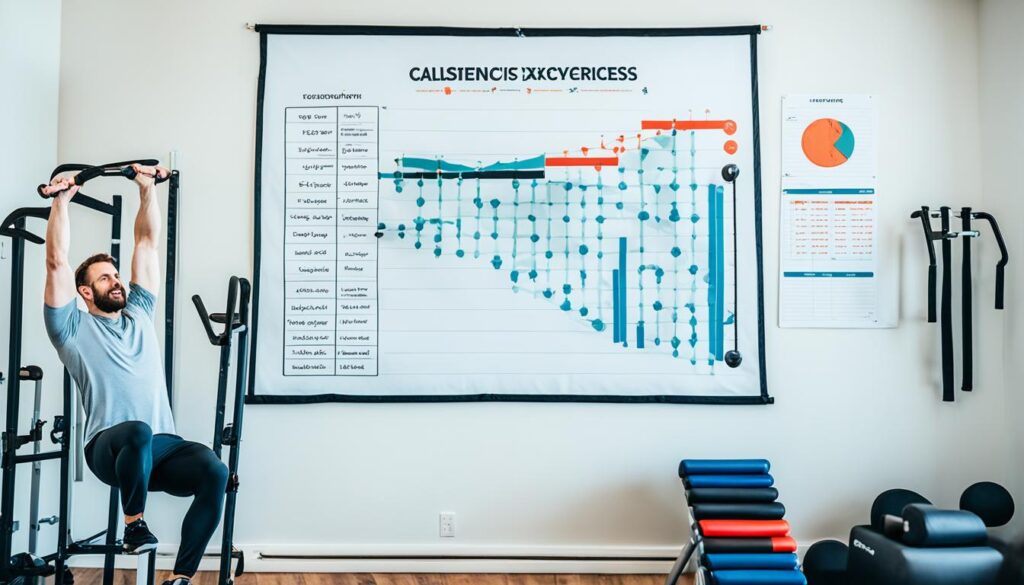
Conclusion
Now that you have all the tools necessary to build a successful calisthenics workout plan at home, it’s time to put your knowledge into practice. Remember to assess your fitness level and set achievable goals, choose exercises that meet your needs, structure your routine carefully, and pay attention to rest and recovery. Make sure to track your progress, adapt your routine as needed, and stay motivated and accountable. With dedication and consistency, you can create an effective home-based calisthenics routine that helps you achieve your fitness goals and live a healthier, more fulfilled life.
FAQ
How do I assess my fitness level and goals for home-based calisthenics workouts?
To assess your fitness level, you can perform basic exercises like push-ups, squats, and planks and note the number of repetitions you can comfortably do. For goal-setting, consider what you want to achieve, such as building strength, increasing flexibility, or shedding fat. This will help you tailor your home-based calisthenics workout routine to your specific needs.
What are the best calisthenics exercises for home workouts?
There are numerous calisthenics exercises suitable for home workouts, including push-ups, squats, lunges, planks, mountain climbers, and burpees. These exercises target multiple muscle groups and can be modified based on your fitness level. Incorporating a variety of exercises will ensure a well-rounded workout routine.
How should I structure my home calisthenics routine?
A well-structured home calisthenics routine should involve a combination of upper body, lower body, and core exercises. You can start with a warm-up, followed by alternating sets of different exercises and incorporating rest periods in between. Ensure that you target different muscle groups and include both strength and cardiovascular exercises.
How often should I do home-based calisthenics workouts?
The frequency of your home-based calisthenics workouts depends on your fitness level and goals. As a general guideline, aim for at least three sessions per week, allowing for rest days in between to allow your muscles to recover. Adjust the frequency based on your progress and recovery ability.
How can I continuously improve with my home calisthenics routine?
Progression is key in improving with your home calisthenics routine. You can increase the difficulty by adding more repetitions, performing exercise variations, using resistance bands, or incorporating more challenging exercises. Gradually increasing the intensity and complexity will ensure continuous improvement over time.
What can I do if I have limited equipment options at home?
If you have limited equipment, you can still achieve an effective calisthenics workout routine at home. Many exercises can be modified to use bodyweight and variations can be performed to target different muscle groups. For example, you can do tricep dips on a chair instead of a dip bar or use a sturdy doorframe for pull-ups.
Should I include flexibility and mobility exercises in my home-based calisthenics routine?
Yes, it’s important to incorporate flexibility and mobility exercises into your home-based calisthenics routine. These exercises improve joint range of motion, prevent injuries, and enhance overall performance. Stretching exercises like hamstring stretches, shoulder stretches, and hip openers can be done before and after your workout.
How important is rest and recovery in a home calisthenics routine?
Rest and recovery are crucial in allowing your muscles to repair and grow. It’s recommended to include rest days in your home calisthenics routine to prevent overtraining and fatigue. Listen to your body, ensure you’re getting enough sleep, and prioritize recovery strategies like foam rolling and stretching.
How can I stay motivated and accountable during my home workouts?
To stay motivated, set specific goals, track your progress, and reward yourself for achieving milestones. Create a dedicated workout space, establish a routine, and find workout buddies or online communities for support and accountability. Also, mix up your workouts to keep them interesting and engaging.
How do I track my progress and make necessary adjustments to my home calisthenics routine?
You can track your progress by recording your exercises, repetitions, and sets in a workout log or using fitness-tracking apps. Assess your performance periodically and adjust your routine by increasing the intensity or duration of exercises, incorporating new exercises, or adding resistance. Regularly reassess your goals and modify your routine accordingly.
Conclusion
Congratulations! By following the steps outlined in this article, you now have the knowledge and tools to create an effective calisthenics workout routine at home. Remember to tailor your routine to your fitness level, goals, and available equipment, and stay consistent and motivated to achieve optimal results. Start your home-based calisthenics journey today!


Leave a Comment